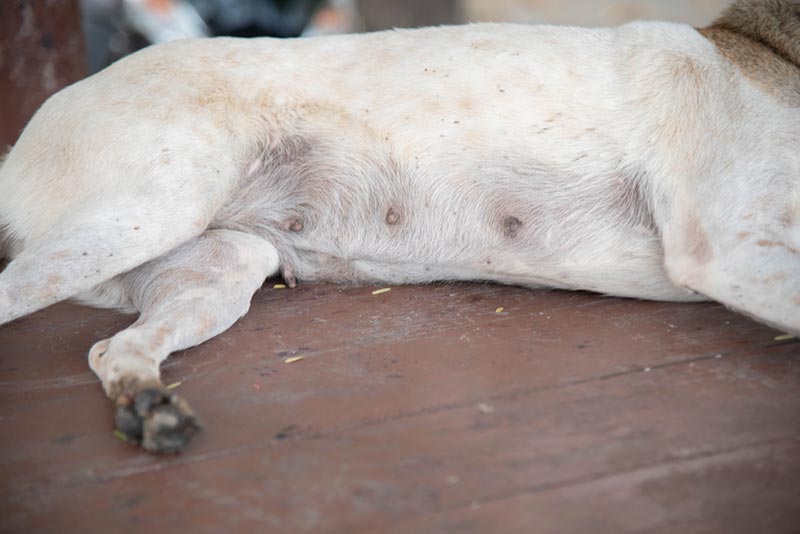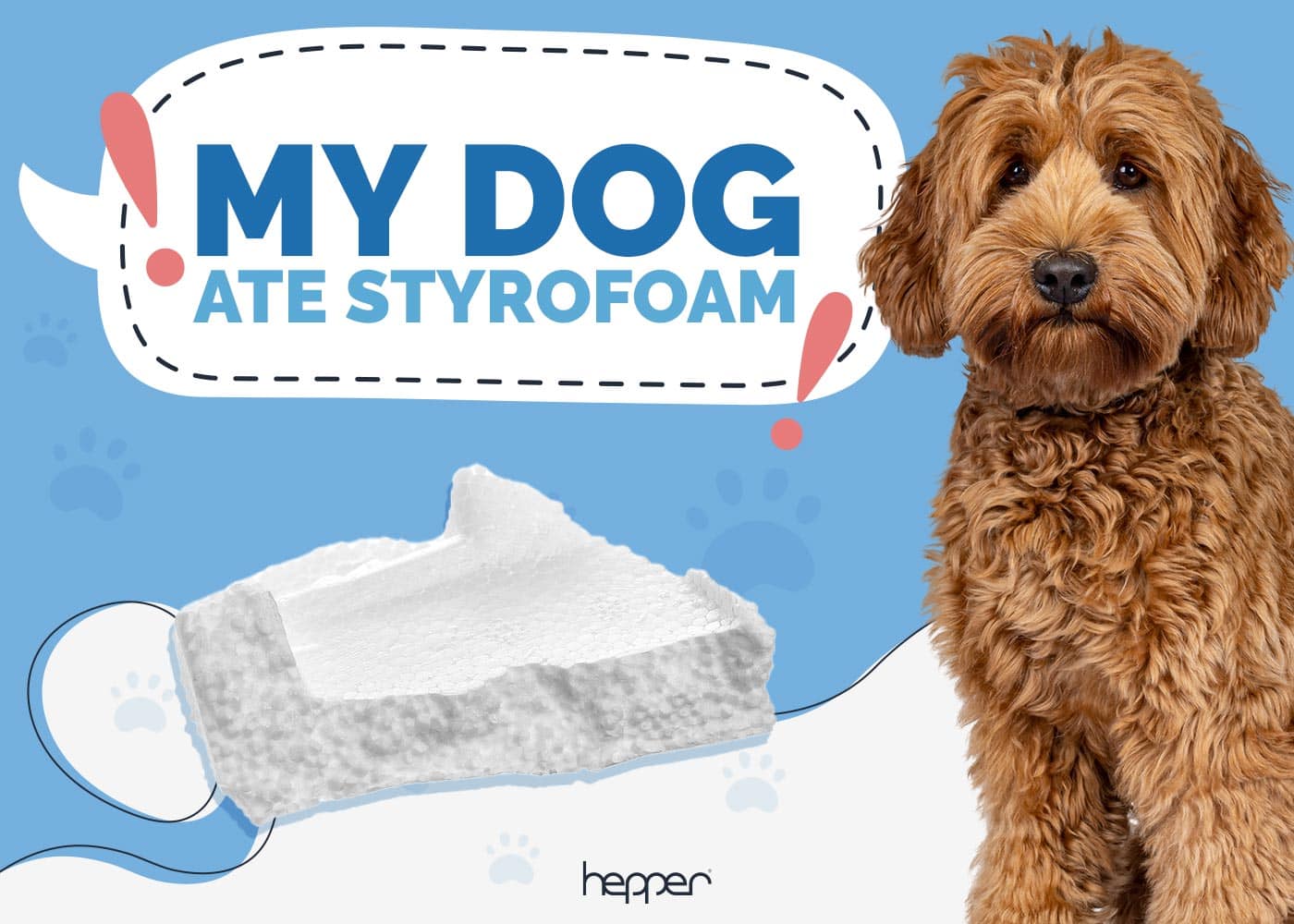Cat Acne vs Chin Mites: How to Tell the Difference (With Pictures)
Updated on
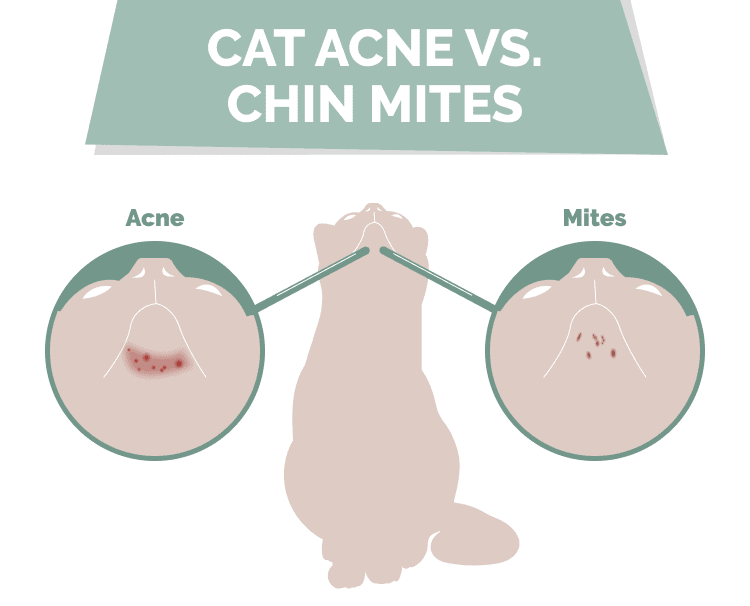
You may not commonly think of your cat’s chin as somewhere that medical issues might occur. Chins are for rubbing, right? But what happens when you are rubbing your cat’s chin and you encounter some strange black debris? Or scabs? What if you find bumps that look like pimples?
Well, lots of strange things can occur on cats’ chins, and feline chin acne is one of them. Very similar to acne in people, feline chin acne can present with all of the above findings. Further, it is one of the more common issues vets see.
Mites can also be found on the skin of cats, and the chin is no exception. Therefore, if your cat is having issues with their chin, determining if chin acne, mites, or something else is at play can be important. If you’re uncertain, the good news is that it is most likely acne if your cat is otherwise healthy and acting normal.
Read on to learn more about these conditions of the cat chin and how to tell the difference between them.
Overview of Cat Chin Acne
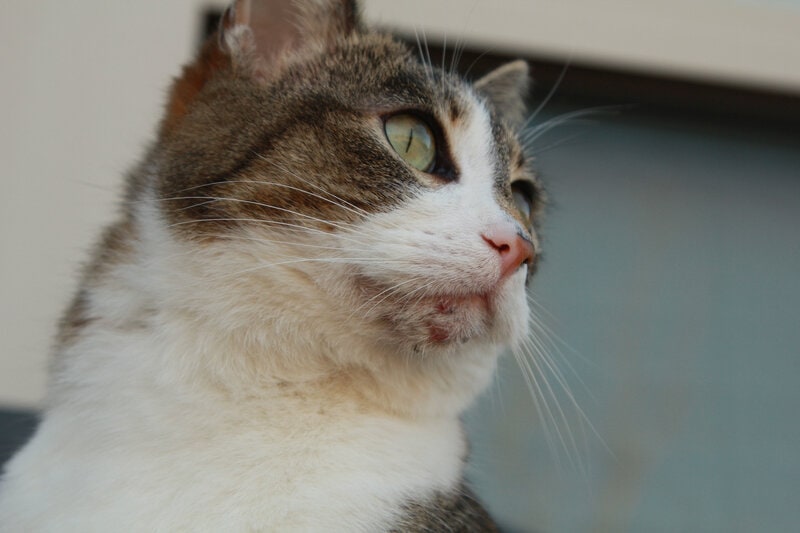
Just like people, cats can suffer from acne, pimples, and blackheads. However, in cats, the condition generally tends to be localized to the area around their chins—hence the name, “chin acne”. And unlike in people, cat chin acne tends to affect middle-aged and older cats, though it can occur at any age. No difference is noted in occurrence by breed or sex.
There is no definitive answer as to what causes chin acne in cats, but it does generally seem to only affect the chin! So, unlike with humans, cats can’t get acne on their faces, backs, etc. Some theories suggest that chin acne may be caused by dirty food or water dishes, or even food or water dishes that are made of plastic and may, therefore, be more likely to trap bacteria. Other cases of chin acne in cats seems potentially related to allergies—both allergies to topical irritants and certain types of food.
In some instances, acne may also be caused or worsened by the presence of skin mites (more on this in the next section).
Chin acne can start with mild cases where only a few blackheads or pustules are present. However, in some cats, the condition can become quite severe, involving the entire chin, leading to marked swelling and deep infections, and being very resistant to treatment. Hair loss, redness, and discomfort can occur in any of these cases.
Often, once chin acne occurs in cats, it will recur at some point in the future. Some cats suffer chronically from this condition for their entire lives.
- Similar appearance to acne in people: blackheads, pustules (pimples), and skin redness
- Sometimes, blackheads occur in large numbers, leading to a dry black discharge that can be combed out of the chin
- Severe cases can be difficult to treat
- Can be painful
- Treatable
- Affects cats of any age but is most common in middle-aged and older cats
Overview of Cat Chin Mites
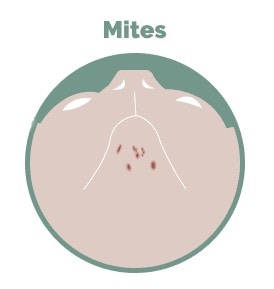
Technically, there is no one specific cat chin mite, which is probably good news for cats, as they already have enough other weird skin conditions to worry about! Therefore, it is more likely that certain skin conditions, such as feline chin acne (as described above), have been anecdotally diagnosed as cat chin mites.
However, that’s not to say that there aren’t mites that live on the chins of cats. Mites are small bug-like organisms (actually arachnids) that often come in groups, and live in nature, in our homes, or on our pets.
When on the skin of cats, they can cause issues ranging from itching, hair loss, small bumps or redness on the surface of the skin, or scabbing. Sound familiar? It should, as lots of these signs are exactly the same as what is seen in feline chin acne.
It’s important to remember that some cats may react differently to mites. Some individuals may show no clinical signs, while others may be severely impacted. The good news is that even though mites can be frustrating, much like acne, they are rarely life threatening. Mites are diagnosed in different ways, depending on the mite. Some are visible with the naked eye, especially if they are present in large numbers, though they will still be very small (think poppy seeds or smaller).
You may suspect mites are present due to the presence of the above clinical signs, but if the mites are too small to view with the naked eye, you will need to enlist the help of your vet to make the diagnosis. This can then be done via a trichogram, which means taking a pluck of some hair in the affected area of the body or collecting some of the suspected mites using tape, then looking at these samples under a microscope.
The following is a list of mites that can be found on the face, head, and chin areas of a cat’s body:
- Cheyletiella mites
- Otodectes mites
- Demodex mites
- Trombiculid mites
- Sarcoptes mites
- Notoedres mites
- There is no one specific chin mite in cats
- More commonly, issues like chin acne are likely misdiagnosed as chin mites
- Mites can exacerbate or be found in some cases of feline chin acne
- Some mites can be seen with the naked eye, but this is not the case for all mites
- Some mites can be contagious to other cats, dogs, and people in the environment
- Generally not life-threatening
- Often have a similar appearance to feline chin acne
Frequently Asked Questions
What Else Can Look Like Cat Chin Mites or Acne?
Chin acne is a pretty specific skin condition with few other lookalikes. However, the blackheads that create a black, powdery debris in the fur of affected cats can look very similar to flea dirt.
Fleas feed on the blood of cats, and they excrete something called fraas, which is the flea poop that consists of dried cat blood. It has the appearance of dried coffee grounds and can, therefore, look a bit like blackheads. However, the chin is an uncommon area to find this issue in cats.
Flea infestations can also cause similar changes to the cat’s overall coat, as can mite infestations. These can include hairloss, skin redness, itching, scabbing, and overgrooming.
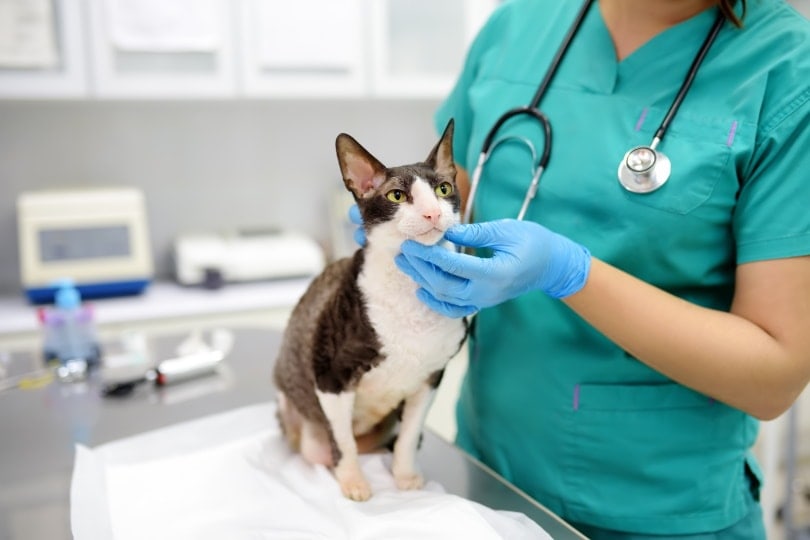
How Are Mites and Acne Treated?
Each condition can have very tailored treatment, which varies quite differently from one another.
Feline chin acne treatments can range from doing nothing and monitoring at home, to more intestive regimes. These can include antibiotics, topical scrubs of the chin, and ointments to help with infections and inflammation. Even special diets or changes to a cat’s environment can help if allergies are suspected.
In the case of mites, cats are often treated with a topical medication that is prescribed by your vet. Some of these come as pills, but many are now applied to the skin on the back of the neck—killing any mites that are present and preventing infections from new ones. Many of these products last around 4 weeks—some for much longer—which can be a real win for cats that are difficult to give pills to. They also often treat fleas and other ectoparasites, making it one medication for treating multiple bad bugs—a cat lover’s dream come true!
Conclusion
Both cat chin acne and chin mites can have overlapping presentations, which can include skin irritation, skin redness, and chin lumps and bumps that look like pimples. If any question ever arises, take photos and show them to your vet. Don’t fret too much, as both conditions tend to be quite treatable. The good news is that neither condition tends to be life threatening, and your cat should be feeling fine again in no time!
Featured Image by Hepper – You are welcome to use our images, but we require you to link directly to this site for credit (ex. Image from Hepper)




